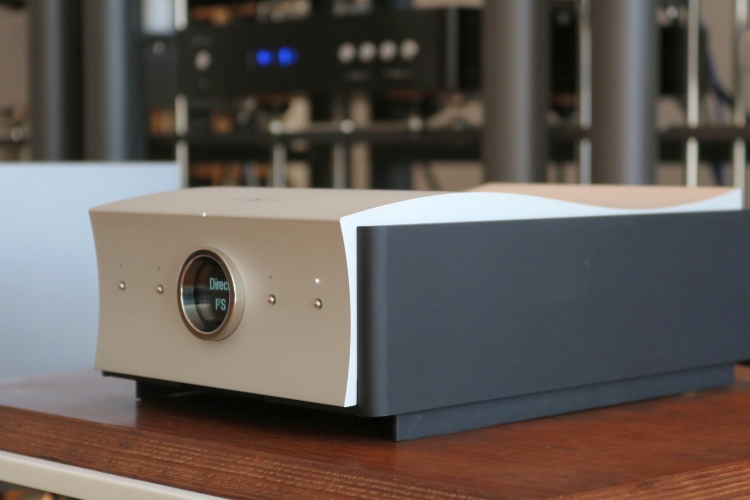
Review organized by Marc Loubeau / Prestige Audio Diffusion
Review sample provided by Terrason
Retail price in the EU (incl VAT): 10.000 euro
Originally available only as a two-board stack for use inside the Mola-Mola Makua preamp, the DAC with its special proprietary design is also available as a separate unit. Admittedly, it has been on the market for 2 years so I’m a bit late to the party, but still, better late than not at all, right?
All incoming digital audio is upsampled on the first board to 3.125MHz/32 bits and converted to noise-shaped PWM. On the second board are two mono DACs, in which a discrete 32- stage FIR DAC and a single-stage 4th order filtering current to voltage converter convert the PWM into analog with what may well be a record-setting 130dB signal to noise ratio. According to Mola-Mola, this is near the theoretical limit for 24-bit files and far beyond that of even quad-speed DSD. Further, the measured distortion is claimed to remain below the noise floor even for full-scale signals.
Although the implementation is proprietary, in essence, the Tambaqui is a bitstream DAC. Historically, I have always preferred multibit DACs or NOS DACs over bitstream variants. But, as the listening tests would soon reveal, the Tambaqui threads a unique sonic path.
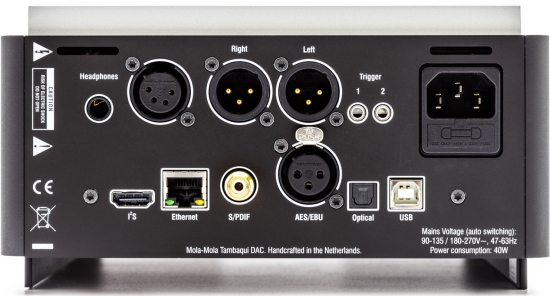
In addition to I2S, S/PDIF coax, AES/EBU, TOSlink, and USB, the Tambaqui is also RoonReady, and it offers an RJ45 network input that can be used to stream Roon signals to the unit. Inside is a full-fledged endpoint/network renderer that makes external streamers superfluous. The analog outputs are available only on XLR but there’s also a headphone output on the rear that can be controlled separately from the Mola-Mola remote control software for iOS and Android that can run on a phone or tablet.
The Tambaqui can process PCM up to 384kHz/32 bits (>192kHz and >24 bits via USB and Roon only) and DoP and Native DSD up to quad speed (USB and Roon only).
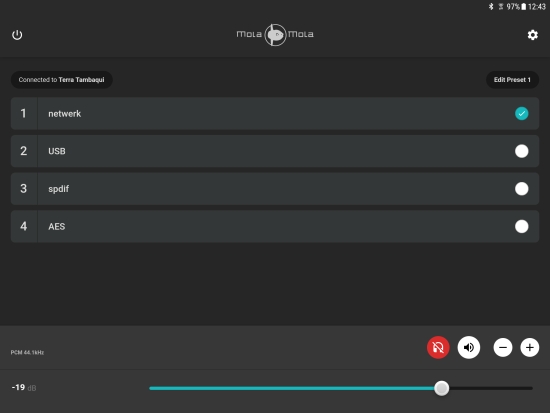
Operation
While the Tambaqui is originally designed to be used with an analog preamp (the Makua), it does contain a digital volume control that works via the supplied standard Apple IR remote control or the excellent iOS/Android app (see image above). The Apple remote control works with RC5 code, and as such, any other likewise-coded remote control for a similar device should also work.
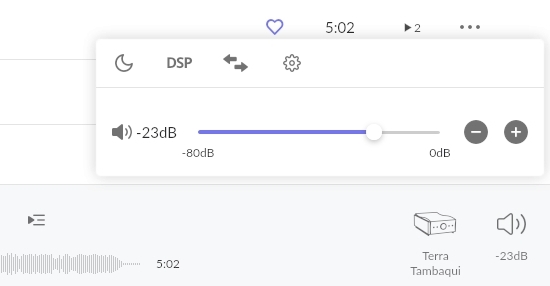
With its volume control enabled, the volume can be controlled directly from within the Roon interface. Incidentally, the Tambaqui’s 4 front panel buttons can be freely assigned to any function from the app. For instance, they could be representing 4 inputs or volume buttons, an input toggle, and another function.
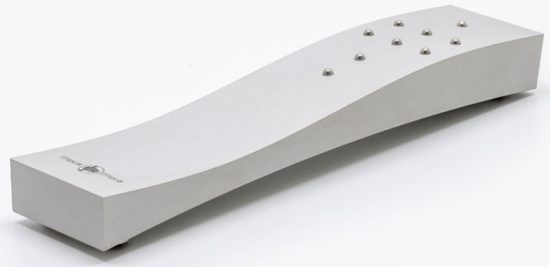
Additionally, a Premium Remote Control is optionally available for 750 euros (see image above). Milled from an aluminum block and possessing a curvy and svelte shape, it contains all the required buttons for the Tambaqui as well as functions for the Makua preamp and the Kula integrated amplifier.
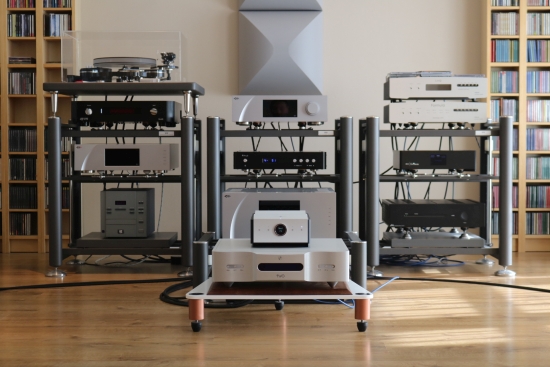
Review context
The Tambaqui will be listened to in combination with two different Music Servers: the Antipodes K50 and the Grimm Audio MU1. In its capacity as a DAC with a fixed volume level, the Tambaqui will be compared to the Aqua Formula xHD DAC (with V2 output board), both connected to the Audio-GD Master 1 analog preamp that in turn feeds the CH Precision A1.5 power amplifier. In its capacity as a DAC with variable volume level, the Tambaqui will be compared to the CH Precision C1 DAC, connected directly to the A1.5 amplifier. The speakers, for the most part, are the Magico S1 MkII connected with Jorma Trinity speaker cables but I will also briefly involve the Aequo Stilla Active speakers. To assess the Tambaqui’s built-in Roon endpoint, finally, I will also involve the Aqua LinQ dedicated network interface. All power cables are Belden with Bals Schuko and Oyaide C-004 IEC connectors and the interlinks are CH Precision Balanced Link XLR cables.
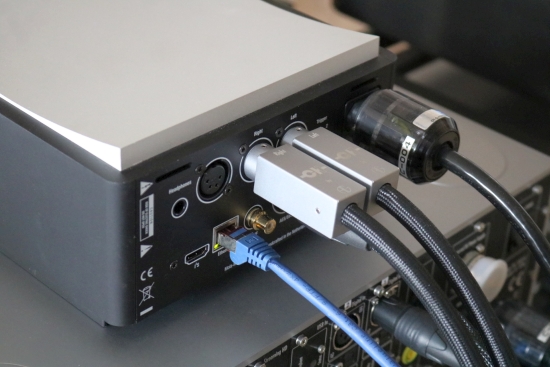
Warm-up
I was informed that the Tambaqui needs a couple of hours of warm-up time (literally) in order to sound its best. While I often also listen to how a component sounds straight out of the box, in this case, I switched it on and left it alone for more than a day prior to my listening tests. Thus, I have no impression of what it would sound like when cold. The DAC becomes warm to the touch but it does not get not hot and it can safely always be left switched on.
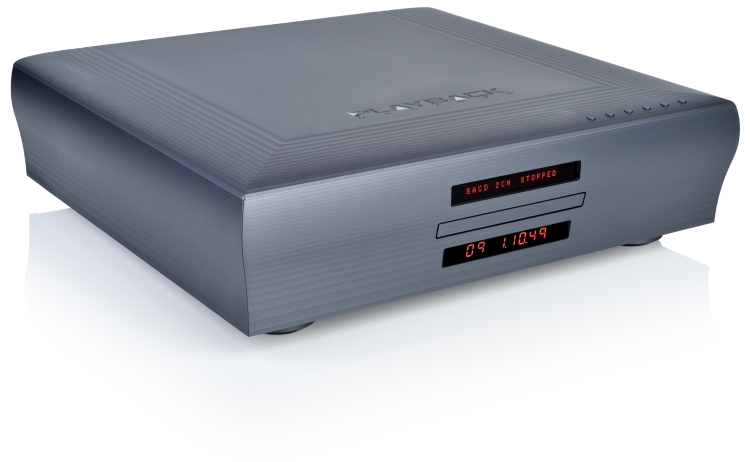







Christiaan,
great review,
however I missed some info about listening via the USB input of the Tambaqui. Did you perform some listening via USB as well?
Thanks
Matt
Hi Matt, I did indeed and it resulted in the expected differences with my having a preference for AES/EBU over USB. Because that has been my preference for some time now I think I forgot to mention this in the review. Basically, I usually find USB to sound slightly technical and over-controlled. Which is funny because the first two USB DACs that I reviewed (Musical Fidelity V-DAC and Ayre QB-9) actually sounded remarkably fluid, and at that time, I attributed that to the interface format. Oh well… For more info on why I prefer AES/EBU, see my latest Antipodes reviews, the Melco review, and the Aqua LinQ review.
Hi Christian how would you compare Tambaqui versus the Meridian Ultra DAC please. I originally owned the Ultra but went back to both my Wadia 27ix and 521. Thanks
I actually was thinking about the Ultra DAC the other day. Alas, it was a long time ago in a time that I had not heard many of the top-tier DACs that I know now, including the Tambaqui (which did not exist at that time). Hence, I cannot be sure how it compares with the Tambaqui. Still, I do recall being impressed with the Ultra DAC. I would not buy it new now but if you find it second hand at a low price it’s worth a “gamble”.
Great does the Mola Mola have the tonal richness of the Wadia ?
No, it does not. Very few DACs do. Tambaqui is more in line with Aqua Formula, Weiss DAC 502, and Playback Designs.
Hello,
As always a very interesting review. Thanks for this website and the effort you put in it. Very entertaining and great reading.
Thanks, Kees!
Christiaan,
Thank you for the excellent review. When you used the Tambaqui (in Roon endpoint mode) fed by the Grimm MU1 how were the two devices connected?
Regards
Nick
Hi Nick, both were connected to a regular Linksys switch using my preferred cheapo OEM brand CAT6 cable.
Bonjour Christian
Très beau test comme d’habitude … Félicitations
Merci, Bruno!
this is one of the best d/a converters on the planet..it has a natural flow and spacious presentation without the glare or edginess of a lot of dacs ..it just simply smoked the MSB Reference dac which was surprising to say the least..
Indeed, it really is a great DAC!
Hi Christiaan,
Great site, Great reviews. I own the Bricasti M1SE. You think its worth upgrading to the Aqua or the Mola Mola Dac ?. I use a Audionote UK level 4 transport. Not much into streaming at the moment. I am mainly an LP (analog) listener. Which one of those Dacs works best with a transport ?.
Take care.
Hi Clive, As I have found, LP playback can be sweet and relaxing or direct and hard-hitting, depending on the configuration and setup. As such, this doesn’t really provide any clues, but I will assume you are referring to a slight forgiving quality. It is just very slightly polite. When speaking of the Bricasti M1SE, Aqua Formula xHD, and MolaMola Tambaqui, I don’t think it’s a matter of upgrading or downgrading. You won’t start hearing better low-level resolution or wider imaging or better focus, for that matter. Rather, it’s a matter of shifting aspects and preferences. The Bricasti has a finely nuanced and fluid, slightly smooth, and slightly rich sound. Of the three, it is the most forgiving. Both the Aqua and the MolaMola will provide a comparatively more articulate and more direct sound that’s arguably also drier and more matter of fact. This is more the case with the Aqua than with the MolaMola but the Aqua also has the most incisive bass and the most expressive midrange. The MolaMola has very nearly all of the Aqua’s aspects but provides a slightly more refined and slightly sweeter sound. Of these three, I don’t think any of them stands out positively or negatively on the matter of synergy with the Audionote CD transport. Oh, what I do think is worth noting is that both the MolaMola and the Aqua’s timbres strike me as more natural. The Bricasti, in comparison, sounds very slightly synthetic to me. Particularly in the midrange, I hear this as piano sounding more like string and wood with the Aqua and the MolaMola then with the Bricasti.
Hey Christiaan,
Thanks for the reply. Looks like the differences between the 3 is not that huge. I fully agree, it usually comes down to personal taste and system synergy. I am now thinking if its worth spending extra cash for a upgrade . I have the opportunity to listen to the Mola Mola here in the New York area. I might go ahead and do that. My M1 SE also have the MDX upgrade that was implemented in 2020. I also considered a ANUK Level 4.1 signature DAC but, that would be an expensive upgrade. In my Audio system right now, the M1SE is pretty enjoyable. I will probably stay with that for a while. Wow, you really cover a wide rang of stuff. To mention Analog, I would love to hear a Orgin Live Soverign TT / Enterprise arm. Very attractively priced at the moment.
The package you have is talked about a lot here in the USA. Ok, this is it for now. Keep on doing it my friend. You are among the best out there.
Thanks again, Stay safe.
Thanks, Clive! If you get the chance, do listen to the Tambaqui. It may or may not be your next DAC but it certainly is one of the great benchmarks out there.
Thankyou for the review,
Originally I bought this DAC to use in combination with the Kula monoblocks and we found the sound to be dry so I ended up adding the Makua preamp sooner rather than later. It never occurred to me to drive the kula’s at a lower voltage, this could have saved considerable heartache. Thankyou for the insight, I will give this a go just for the fun of it, although I am very happy with the makua as a preamp.
The lower voltage is a good option to know about, but still, I would say that the Tambaqui is not ideal to be used as a standalone front end. But when there is an analog preamp is in the chain, the DAC is really great.
I will be heading in a different direction. I went ahead and put in an order for a SW1X level IV Balance Dac. I will see how it goes.
Hi Christiian,
I now have the Tambaqui and really enjoy it! I use it as a Roon endpoint and am very happy that way. However, I have an opportunity to get a K50 at a reasonable price. I know that the K50 will give me some other options like aes and I2S outputs into the Tambaqui but I am not sure of better sound quality. I use a Small Green Computer I7 as Roon Server/player on a completely isolated leg of my network just for audio with modded Buffalo switches and a couple of fiber connections.
Regardless of the input from the K50, the Tambaqui is still going to upsample to 3.1 mhz and convert to PWM etc.
So is the K50 reclocker going to be better than the Tambaqui clock?
The aes and I2S are limited to 192/24 on the Tambaqui. Perhaps that does not matter due to the Tambaqui processing for the end result?
Any thoughts?
Hi Jeff, the Tambaqui’s processing does not negate the quality of the source in any way. Instead, the DAC’s incredible linearity and neutrality and its ultra-high-resolution will make upstream differences more obvious. I’ll wager AES/EBU will sound best in terms of musical coherence and natural organic flow. The K50 offers USB as well as the Reclocker outputs which enables you to select the best-performing one for your situation. USB quality varies greatly depending on the implementation of the interfaces on both end but I think that it will still outperform the Tambaqui’s built-in Roon endpoint. Don’t get me wrong – it is great in its own right but the DAC itself can perform even better if you serve it AES/EBU.
Hello Christiaan,
My system has indeed gotten better with the addition of the K-50 along with the Tambaqui. I use both aes/ebu with Nordost Valhalla 2 and I2S with Tubulus Concentus. They both sound very similar!
For my next move I will be taking delivery of an Esoteric Grandioso S-1 amplifier. Currently I am using an Aesthetix Mimas integrated and have set the Tambaqui at 6 volts direct, so using the Mimas pre amp section.
Now the dilemma…. Should I use the Tambaqui volume control? Should I use the Mimas pre outs or should I dive into a crazy good preamp.
I have access to an Esoteric C-01X for 21,000 US.
I have access to a Block Audio Pre for 19,500. US.
I have access to an Emm Labs Pre for 12,000. US.
Or maybe a CH L1?
I just don’t know if it is worth the extra cash. Do you have an opinion please?
Hi Jeff, The Tambaqui is an excellent DAC, but it sounds best when used with an analog preamp. Without one, it can become a little too lean and clean, subjectively lacking some color saturation and soul. Also, it sounds best with its higher output voltage setting. Of the four preamp options you mention I only heard the L1 so I can’t really comment:-) As long as you’re considering options, I would also include Spectral and Aries Cerat. See my preamp reviews for more info.
I agree, the tambaqui digital volume control takes away some of its musicality. I found this and ended up buying their preamp to use in conjunction. Later adding their phono stage to it as well.
Ah, yes, the Mola-Mola Makua preamp is really good, too!
Thank you for your replies guys.
I am thinking my system sounds really good because I am using an Aesthetix Mimas with NOS tubes in the pre section!
Hello Christian,
Great review as usual! You made a great point about how most modern DACs, at least the Delta-Sigma variants tend to sound bright and edgy. I’m particularly sensitive to this glare in the low treble area which is part of the reason why I stick mostly with vintage R2R DACs…
I recall you giving a high praise to the older Mark Levinson 360S and Wadia 27ix. Do you think that the Tambaqui offer significant improvements over these old stalwarts?
Cheers,
Brian
Hi Brian, I much liked the 360S and 27ix indeed but they are quite different from one another, and again, quite different from the Mola-Mola Tambaqui. The latter has higher resolution and a higher degree of precision and transparency than the Levinson and Wadia. But it is on the clean/analytical side compared to the lush and smooth Levinson and on the lean side compared to the Wadia. The current reality of course is that it’s actually the inverse, the Levinson being a little too smooth and the Wadia being a little too thick and dark. But for those accustomed to the aforementioned lush/smooth/full-sounding classic DACs, both the Aqua and the Mola-Mola can appear to be on the clean and lean side.
With my current preferences, however, I would not want to go back to either the Wadia or the Levinson. The Tambaqui is very neutral and even-handed and actually not too dissimilar from the Aqua Formula xHD which I also regard highly.
Hi Christian,
Thank you for the great advice, I really took it to heart. I tried auditioning the Tambaqui in my system but you’re right, I find it a bit “clean and lean” compared to the classic R2R DACs that I’m already accustomed to. My front end is a bit on the analytical side so I found this DAC a bit too dry there despite the great resolution and smoothness.
Unexpectedly I ended up with a Rockna Wavelight, a “modern” R2R DAC that seems a little less known. I think in terms of sheer resolution it’s a step behind the Tambaqui but its slightly more forgiving nature and the ability to apply a vinyl-like quality to the sound work better in my system. It seems that after all I cannot escape from R2R after all!
Cheers,
Brian
Hello, thanks for your reviews, which helped steer me in the decision between a K50 and MU1. I now have a MU1 and a Tambaqui on the way, after trying an Aurender N20 which I found to be lacking in high frequency clarity and detail.
Can I ask, which version of the MU1 were you testing with the Tambaqui? Was it the updated MU1 that you found to be a bit less smooth/liquid/organic, or the original?
If I find the MU1 to be too dry when combined with the Tambaqui, I can always switch to the K50. But I usually seem to gravitate to transparency/resolution, provided the sound is solid, palpable and physical. If it doesn’t work out for me, I can always pivot to something else!
Thanks again!
Can
Hi Nigel, I’m actually not sure if that was pre- or post MU1 update, but it was probably before. Then again, the Roon 2.0 update did steer things back toward smooth and relaxed. What remains is that the MU1 with the latest firmware update and with Roon 2.0 does not have the same level of sonorous ballsiness as before. That said, I can imagine one finding the MU1-Tambaqui combination a little too dry either before or after the updates. The combo is very articulate, transparent, and precise and this requires a very nice analog preamp. Please also keep in mind that the K50 and MU1 are very different and will require different tweaking in the system to achieve the best synergy.
Christiaan, I received my MU1 to pair with my Tambaqui. At first I wasn’t sure if I liked it as the soundstage wasn’t even. But after adjusting my speakers’ toe-in and distance apart, everything clicked into place! Everything you have said in your reviews led me to the right sound for me and my system even if some of your assessments were made at a point in time while vendor updates subsequently changed things. I’m very glad I went the MU1 route over other options. I can’t get over how precise and detailed it is with the Tambaqui and yet everything is musically coherent and so easy to listen to, unexpectedly even with poor recordings. Totally unforced and works with any types of music! The impact and solidity helps convey the musicality regardless of the quality of recording. My Diablo 300 is known to be richer leaning so with this combo, I’m not finding the sound to be at all too lean or dry, thankfully. Sounds just like people playing music to me! Thanks again for all of your helpful and comparative descriptions. After hearing the MU1/Tambaqui together, I’m fairly certain the K50 would not have appealed to my tastes.
I’m happy to hear my reports have been a helpful guide on your audio journey 🙂
Hi Christiaan,
I now have a Tambaqui, but was wondering how the Formula xHD Rev 2 compares to my fish!
I feed it from a K-50.
Hi Jeff, the comparisons that I make in the review are with the Rev 2 version of the Formula xHD.
Hi Christian; terrific review!
I’ve had the Tambaqui DAC in my system now (running on fixed volume connected to a Krell preamp) for about 2 months and love it. I’m feeding it with my Sonore Optical Rendu SE, and while I’m a huge believer in the benefit of fiber optics, I’m struck by your belief (supported by others) that AES/EBU bests the performance of USB. As you may know, the Sonore as no AES output. Ouch!
So my question is, given I just invested in a SGC server which runs like a tank, is there ANOTHER optical streamer you could point me to that DOES support AES/EBU?
Thank you!
Hi Bob, I would not say that AES/EBU always sounds best because that is a relative matter. But I do feel that it provides a more predictable connection than USB, and usually works best for me. That said, I have also encountered occasions where USB works great. All in all, if you like what the Sonore and Tambaqui are doing then I wouldn’t worry about it:-)
Thank you, Christiaan; I appreciate your wise advice here. Yes, I’ve got a world class USB cable form Sablon Audio and am very happy with the performance so I suppose I’m needlessly concerned about any nominal improvement I might gain by use of a different type of cable.
Next step up for me (I think) is to upgrade to the Mola Mola Makua to replace my Krell preamp!
Thx for the advice!
Hi Bob, I’ve not heard many Krell preamps but can tell you that the Makua is highly transparent, well-resolved, very lineair, and refined. It is very much “invisible” and it works well with the Tambaqui. You could also consider getting the Makua version with the Tambaqui DAC board.
Thanks very much Christiaan; I appreciate your advice. Krell is a fantastic preamp but in our hobby we always aspire for better, right? Since I already have a Tambaqui, the bare-bones Makua preamplifier shall be my next aspirational piece. 😎🙏
Hello, Christiaan. I have this gear chain: modem with linear supply – uptone ether regen switch with linear power supply – mola mola tambaqui with ethernet – diablo 300 – proac d48r. I like it very much, but what do you think, is it possible to improve it without thousands eur more? I had Auralic Aries G1, but with AES/EBU good Clarus cabel it was worse than Tambaqui ethernet.
It depends on what you are personally after. Lushness and “analog” feel, or clean absolute neutrality? Roon streaming to Tambaqui sounds fluid, smooth, and free-flowing, but I feel it is a bit too laidback, lacking incisiveness, tension, and vitality compared to using a good AES source. In my case, the Grimm MU1 lead to a more desirable result. But some people may find the Grimm comparatively lean or gray. Something I don’t think myself but which could also be said about the Aries G1. They are not too dissimilar in their overall presentation. So, that is a relative matter. All I can add is that if you’re happy now, don’t change too much and if so, take it step by step. Maybe a cable here or there, or some exotic footers.
Hi Christiaan,
you do prefer the AES/EBU input in the Tambaqui. But what do you think using the Tambaqui as a stand-alone device without a transport or music server?
I mean for playing only local HD files. Unfortunately the Tambaqui does not have an internal HARD DISK to store the files, so, do you think that connecting an external HD to the tambaqui would “sound” a lot worse than using a dedicated transport or media server as a source?
I was thinking as the same time at the Bryston BDA 3.14 that has both of them….do you think that the Bryston is in another league (inferior) as the Tambaqui?
Thank you very much
David
The Tambaqui is Roon-Ready and you can stream to it from a Roon core. However, its streaming function has a less expressive, impactful, and dynamic behavior. I found that it sounds best when using its AES/EBU input. I have not tried USB but that may also sound very good. The Bryston BDA 3.14 is really nice but very different in sonic presentation. I would regard Tambaqui as more audiophile, although some may prefer the Bryston for its fuller sound.
(Forgot to ask if the Tambaqui can be connected instead of an external HD, to a local NAS via ethernet and playing locan files in that way)